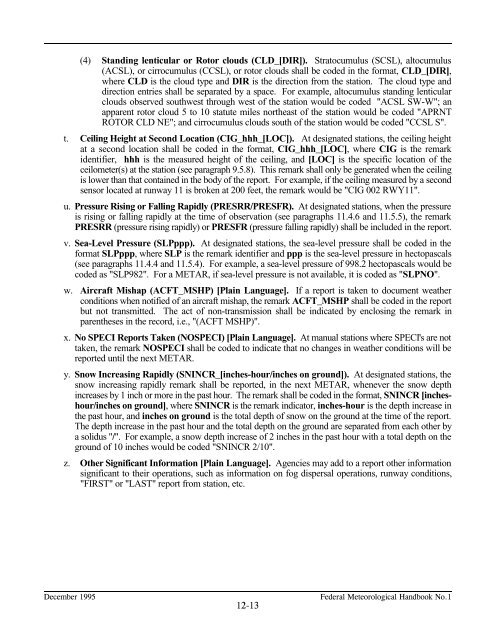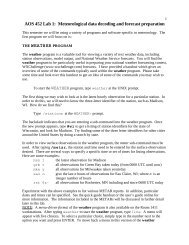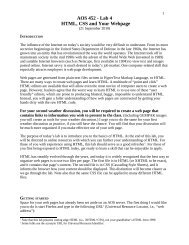Federal Meteorological Handbook No. 1 - Marrella
Federal Meteorological Handbook No. 1 - Marrella
Federal Meteorological Handbook No. 1 - Marrella
Create successful ePaper yourself
Turn your PDF publications into a flip-book with our unique Google optimized e-Paper software.
(4) Standing lenticular or Rotor clouds (CLD_[DIR]). Stratocumulus (SCSL), altocumulus<br />
(ACSL), or cirrocumulus (CCSL), or rotor clouds shall be coded in the format, CLD_[DIR],<br />
where CLD is the cloud type and DIR is the direction from the station. The cloud type and<br />
direction entries shall be separated by a space. For example, altocumulus standing lenticular<br />
clouds observed southwest through west of the station would be coded "ACSL SW-W"; an<br />
apparent rotor cloud 5 to 10 statute miles northeast of the station would be coded "APRNT<br />
ROTOR CLD NE"; and cirrocumulus clouds south of the station would be coded "CCSL S".<br />
t. Ceiling Height at Second Location (CIG_hhh_[LOC]). At designated stations, the ceiling height<br />
at a second location shall be coded in the format, CIG_hhh_[LOC], where CIG is the remark<br />
identifier, hhh is the measured height of the ceiling, and [LOC] is the specific location of the<br />
ceilometer(s) at the station (see paragraph 9.5.8). This remark shall only be generated when the ceiling<br />
is lower than that contained in the body of the report. For example, if the ceiling measured by a second<br />
sensor located at runway 11 is broken at 200 feet, the remark would be "CIG 002 RWY11".<br />
u. Pressure Rising or Falling Rapidly (PRESRR/PRESFR). At designated stations, when the pressure<br />
is rising or falling rapidly at the time of observation (see paragraphs 11.4.6 and 11.5.5), the remark<br />
PRESRR (pressure rising rapidly) or PRESFR (pressure falling rapidly) shall be included in the report.<br />
v. Sea-Level Pressure (SLPppp). At designated stations, the sea-level pressure shall be coded in the<br />
format SLPppp, where SLP is the remark identifier and ppp is the sea-level pressure in hectopascals<br />
(see paragraphs 11.4.4 and 11.5.4). For example, a sea-level pressure of 998.2 hectopascals would be<br />
coded as "SLP982". For a METAR, if sea-level pressure is not available, it is coded as "SLPNO".<br />
w. Aircraft Mishap (ACFT_MSHP) [Plain Language]. If a report is taken to document weather<br />
conditions when notified of an aircraft mishap, the remark ACFT_MSHP shall be coded in the report<br />
but not transmitted. The act of non-transmission shall be indicated by enclosing the remark in<br />
parentheses in the record, i.e., "(ACFT MSHP)".<br />
x. <strong>No</strong> SPECI Reports Taken (NOSPECI) [Plain Language]. At manual stations where SPECI's are not<br />
taken, the remark NOSPECI shall be coded to indicate that no changes in weather conditions will be<br />
reported until the next METAR.<br />
y. Snow Increasing Rapidly (SNINCR_[inches-hour/inches on ground]). At designated stations, the<br />
snow increasing rapidly remark shall be reported, in the next METAR, whenever the snow depth<br />
increases by 1 inch or more in the past hour. The remark shall be coded in the format, SNINCR [incheshour/inches<br />
on ground], where SNINCR is the remark indicator, inches-hour is the depth increase in<br />
the past hour, and inches on ground is the total depth of snow on the ground at the time of the report.<br />
The depth increase in the past hour and the total depth on the ground are separated from each other by<br />
a solidus "/". For example, a snow depth increase of 2 inches in the past hour with a total depth on the<br />
ground of 10 inches would be coded "SNINCR 2/10".<br />
z. Other Significant Information [Plain Language]. Agencies may add to a report other information<br />
significant to their operations, such as information on fog dispersal operations, runway conditions,<br />
"FIRST" or "LAST" report from station, etc.<br />
������������� ������������������������������������<br />
�����





